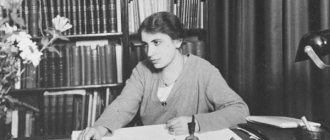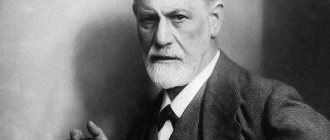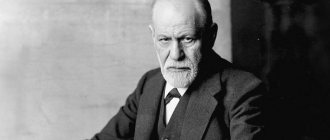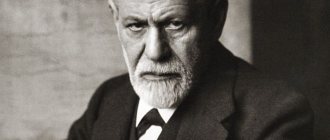- 61906
- Academy of Winners
Great people
Sigmund Freud (full name Sigismund Shlomo Freud) is an Austrian psychologist, neurologist and psychiatrist. He is credited with founding psychoanalysis - a theory about the characteristics of human behavior and the reasons for this behavior.
In 1930, Sigmund Freud was awarded the Goethe Prize , it was then that his theories gained public recognition, although they remained “revolutionary” for that time period.
short biography
Sigmund Freud was born on May 6, 1856 in the Austrian town of Freiberg (modern Czech Republic), which had a population of about 4,500 people.
His father, Jacob Freud, was married for the second time, and had two sons from his first marriage. He was engaged in the textile trade. Sigmund's mother, Natalie Nathanson, was half her father's age.
In 1859, due to the forced closure of the business of the head of the family, the Freud family moved first to Leipzig and then to Vienna.
Zigmund Shlomo was 4 years old at that time.
Personal life
For a long time, Sigmund did not pay attention to the weaker sex. Moreover, he felt some anxiety and fear towards women. One day, on the way to the printing house, he almost ended up under the wheels of a carriage. The passenger, feeling guilty, invited Freud to the ball as a sign of reconciliation. It was there that he met his future wife Martha Beirnais and her sister Minna. A romance broke out between them, which ended in a wedding. Soon, disagreements and squabbles began to arise between the spouses.
Jealous Martha did not want her husband to communicate with Minna. In order not to aggravate the situation, the man submitted to the will of his wife. In this union, which lasted 8 years, six children were born. An interesting fact is that after the birth of his youngest daughter, Anna, the psychologist decided to give up intimate relationships.
Sigmund Freud with his daughter Anna
It was the youngest daughter who took care of her father in the last years of his life. In addition, Anna became the only one of Freud’s children who continued the work of her famous father. Few people know the fact that the man had a phenomenal memory, remembering large amounts of information.
It is curious that during communication Freud never looked people in the eyes. A number of his biographers believe that the famous couch in his room is connected precisely with this feature.
Study period
At first, Sigmund was raised by his mother, but soon his father took over, who wanted a better future for him and in every possible way instilled in his son a love of literature. He succeeded and Freud Jr. retained this love until the end of his life.
Studying at the gymnasium
Diligence and ability to learn allowed Sigmund to go to school at the age of 9 - a year earlier than usual. At that time he already had 7 brothers and sisters . Sigmund's parents singled him out for his talent and desire to learn new things. To the point that the other children were forbidden to study music when he studied in a separate room.
At the age of 17, the young talent graduated from high school with honors. By that time, he was interested in literature and philosophy, and also knew several languages: German perfectly, English, French, Italian, Spanish, studied Latin and Greek.
Needless to say, during the entire period of his studies he was the number 1 student in his class.
Choice of profession
Sigmund Freud's further studies were limited due to his Jewish origin. His choice was commerce, industry, medicine or law. After some deliberation, he chose medicine and entered the University of Vienna in 1873.
At the university he began to study chemistry and anatomy. However, what he liked most was psychology and physiology. Ernst von Brücke lectured on these subjects at the university .
Sigmund was also impressed by the popular zoologist Karl Klaus , with whom he later carried out scientific work.
During his time working under Klaus, "Freud quickly distinguished himself among other students, which allowed him to become a fellow of the Trieste Institute of Zoological Research twice, in 1875 and 1876."
Family life of Sigmund Freud
A year after returning from Paris, Freud married Martha Bernays. He had known each other for four years, but Freud, who did not have a good income, did not consider himself capable of providing for his wife, who was accustomed to living in abundance. Private medical practice brought better income, and in September 1886, Sigmund and Martha got married. Biographers of the great psychoanalyst note the very strong and tender feelings that connected Freud and Bernays. In the four years that passed from meeting to marriage, Sigmund wrote more than 900 letters to his bride. They lived in love for 53 years - until Freud's death. Martha once said that in all these 53 years they had not said a single angry or offensive word to each other. Freud's wife gave birth to six children. Sigmund Freud's youngest daughter followed in her father's footsteps. Anna Freud became the founder of child psychoanalysis.
After university
opened a doctor’s office in 1881 and began treating psychoneuroses. Soon after this, he began to use cocaine for medicinal purposes, first trying its effects on himself.
Colleagues looked at him askance, some called him an adventurer. Subsequently, it became clear to him that cocaine could not cure neuroses, but it was quite easy to get used to it. It took Freud a lot of work to abandon the white powder and gain the authority of a pure doctor and scientist.
Quotes
- “Love and work are the cornerstones of our humanity.”
- “The task of making man happy was not part of the plan for the creation of the world.”
- “The voice of intellect is quiet, but it never tires of repeating – and there are listeners.”
- “You never stop looking for strength and confidence outside, but you should look within yourself. They have always been there."
- “In a number of cases, falling in love is nothing more than a psychic capture by an object, dictated by sexual primary urges for the purpose of direct sexual satisfaction and, with the achievement of this goal, fading away; this is what is called base, sensual love. But, as we know, the libidinal situation rarely remains so uncomplicated. Confidence in a new awakening of a need that had just died out was probably the immediate motive why the capture of a sexual object turned out to be long-lasting and it was “loved” even during those periods of time when there was no desire.”
- “Just today my deceased daughter would have turned thirty-six years old... We are finding a place for the one we lost. Although we know that the acute grief after such a loss will be erased, we remain inconsolable and will never be able to find a replacement. Everything that stands in an empty place, even if it manages to fill it, remains something else. That's how it should be. This is the only way to prolong the love that we do not want to renounce.” — from a letter to Ludwig Binswanger, April 12, 1929.
First successes
In 1899, Sigmund Freud published the book The Interpretation of Dreams , which caused a negative reaction in society. She was ridiculed in the press; some of her colleagues wanted nothing to do with Freud. But the book aroused great interest abroad: in France, England, America. Gradually, the attitude towards Dr. Freud changed, his stories won more and more supporters among doctors.
Getting acquainted with an increasing number of patients, mostly women, who complained of various ailments and disorders, using hypnosis methods, Freud built his theory of unconscious mental activity and determined that neurosis is a defensive reaction of the psyche to a traumatic idea.
Subsequently, he put forward a hypothesis about the special role of unsatisfied sexuality in the development of neurosis. Observing human behavior, his actions - especially bad ones, Freud came to the conclusion that unconscious motives underlie people's actions.
Psychotherapy and psychoanalysis
During his student years in Brücke's laboratory, Sigmund published very interesting articles on the nervous system of some animals. After graduating, he continued to show interest in zoology. Later, the guy worked for several years under the supervision of some famous therapists.
In 1885, Freud applied to open a private neuropathology office. His request was granted. It is known that during this period of his biography he used cocaine, which was then considered a drug.
Sigmund devoted many scientific works to cocaine, where he spoke enthusiastically about the miracle drug. After some time, his delight turned to sadness, as news began to arrive from all over Europe about cocaine poisoning and addiction, as well as the disastrous consequences of its use.
Moreover, one of Freud's comrades died from an addiction to the powder. It is important to note that Sigmund himself eventually became a victim of cocaine addiction. Years later, with a lot of effort, he finally managed to get rid of the addiction.
By that time, Freud, thanks to the support of his colleagues, had an internship with psychiatrist Jean Charcot. While conducting a series of scientific experiments, he began to notice differences between diseases. From his mentor, Sigmund learned to use hypnosis in treatment, through which it was possible to treat some diseases.
In Paris, Freud was deeply involved in neuropathology. He was able to prove the existence of certain connections between hysteria and problems of a sexual nature. The neuropathologist Hippolyte Bernheim, who also used hypnosis, also seriously influenced Sigmund's worldview.
It is curious that it was from the practice of hypnosis according to Bernheim that Freud's psychoanalysis appeared in the future. After some time, Sigmund gradually began to realize the imperfection of hypnosis. In practice, it turned out that its effectiveness was not nearly as high as it seemed.
In a number of cases, treatment with hypnosis not only did not bring results, but also caused harm to the patient. For this reason, Sigmund began searching for new effective treatments. One day, quite by accident, he came across a work by Ludwig Berne, where he read the following phrase: “Write everything that you think about yourself... and after 3 days you will be surprised how many ideas you don’t know are hidden in you.”
For Freud, this idea became a real sensation. He began to use conversations with patients in treatment, allowing them to speak out and change their consciousness. This method became known as the “Free Association Method”.
Random thoughts and unrelated phrases helped the insightful Sigmund Freud to find out the cause of the patient's problem and find its solution. From that moment on, the psychiatrist no longer needed hypnosis, since the “Method of Free Associations” was much more effective.
Freud put forward a theory according to which any psychosis is a consequence of an individual’s memories, which he finds difficult to get rid of. At the same time, he stated that most psychoses were based on the Oedipus complex and infantile childhood sexuality.
According to Sigmund Freud, sexuality was the main factor determining a large number of psychological problems in people. He devoted many scientific works to these problems, including “Three Essays on the Theory of Sexuality.”
Such sensational versions of the psychologist caused a great resonance in the scientific world. Many of Freud's colleagues harshly criticized his ideas. Some of the scientists argued that Sigmund himself became a victim of psychosis. Later, Sigmund’s book “The Interpretation of Dreams” was published.
The author of the work convinced that dreams are a significant factor influencing the physiological state of the patient. Soon, a number of Freud's assumptions were confirmed in practice, and he himself was invited to give lectures at major universities in Europe and the USA.
One of the most important works in the scientific biography of Sigmund Freud is considered to be “The Psychopathology of Everyday Life.” She influenced the formation of the topological model of the psyche developed by the psychologist. His book “Introduction to Psychoanalysis” became no less popular.
In it, the reader could learn the essence of Freud's concepts, the methodology for interpreting theoretical principles and psychoanalysis, as well as the scientist's philosophical ideas. Later, the basics of philosophy will form the basis for the formation of a set of mental processes and phenomena known under the concept “Unconscious”.
In parallel with this, Sigmund set out to shed light on social phenomena. In his work “Psychology of the Masses and Analysis of the Human Self,” he gave examples of a number of factors that influenced the crowd and the behavior of the leader. In 1910, the psychologist's followers were divided into 2 camps.
The first of them rejected the idea that psychosis and hysteria are interconnected with the suppression of the individual's sexual energy (which Freud insisted on), while others, on the contrary, agreed with this. This led to a split and endless disputes, which greatly tired the scientist.
As a result, Sigmund gathered around himself only those who supported him in everything, not wanting to participate in squabbles. Thus, in 1913, a virtual secret community, the “Committee,” arose.
During his biography, Freud published a huge number of scientific works, which were placed on the pages of 26 volumes! However, almost any postulate characteristic of his theory was criticized by authoritative scientists, including Karl Jaspers, Erich Fromm, Frederick Crews, Karl Popper and others.
Theory of the unconscious
Trying to find these very unconscious motives - possible causes of neuroses, he drew attention to the unsatisfied desires of a person in the past, which lead to personality conflicts in the present. These alien emotions seem to cloud the consciousness. They were interpreted by him as the main evidence of the existence of the unconscious .
In 1902, Sigmund was given the position of professor of neuropathology at the University of Vienna, and a year later he became the organizer of the “First International Psychoanalytic Congress”. But international recognition of his achievements came only in 1930, when the city of Frankfurt am Main awarded him the Goethe Prize .
last years of life
Unfortunately, Sigmund Freud's subsequent life was filled with tragic events. In 1933, the Nazis came to power in Germany, Jews began to be persecuted, and Freud's books were burned in Berlin. It got worse - he himself ended up in the Vienna ghetto, and his sisters in a concentration camp. They managed to rescue him, and in 1938 he and his family left for London. But he had only a year to live: he suffered from oral cancer caused by smoking.
On September 23, 1939, Sigmund Freud was injected with several cubes of morphine, a dose sufficient to terminate the life of a person weakened by illness.
He died at 3 am at the age of 83, his body was cremated and his ashes were placed in a special Etruscan vase, which is kept in the Golders Green Mausoleum.
Secret society "The Committee"
The year 1910 brought discord to the team of followers and students of Sigmund Freud. The scientist’s opinion that psychological disorders and hysteria are the suppression of sexual energy did not find responses among the philosopher’s students, and disagreement with this theory led to controversy. Endless discussions and debates drove Freud crazy, and he decided to keep only those who adhered to the basics of his theory. Three years later, a virtual secret society arose, which was called the “Committee”. Sigmund Freud's life is full of great discoveries and interesting research.











